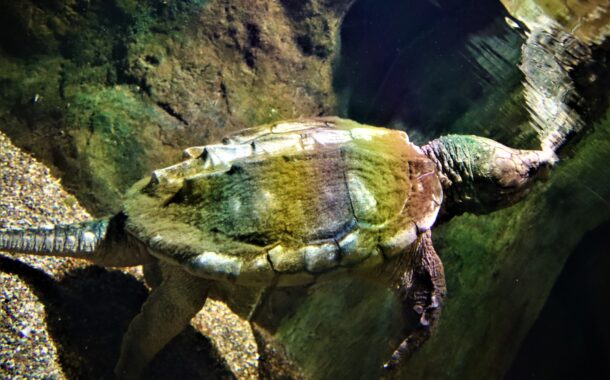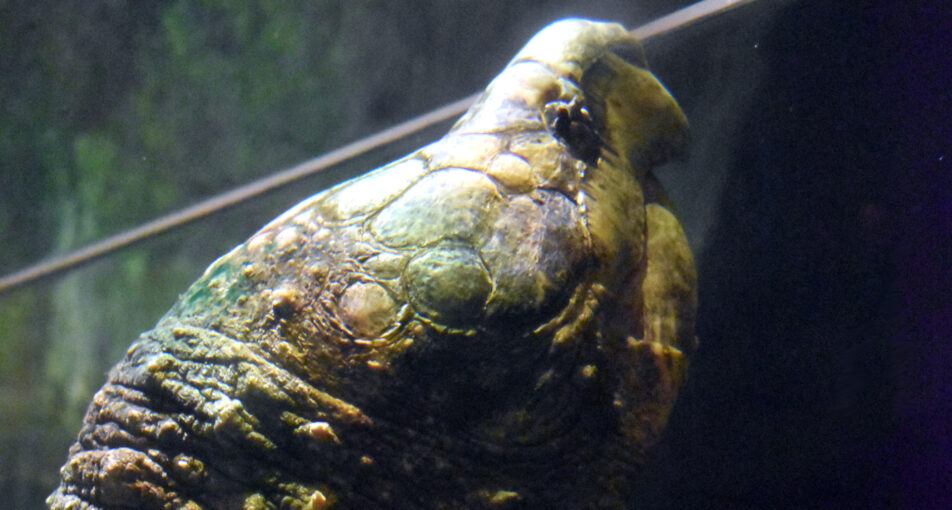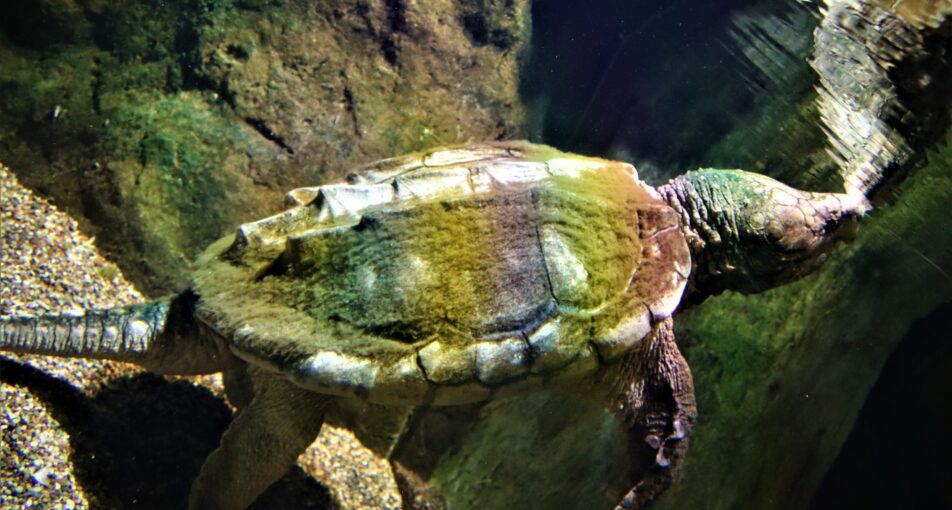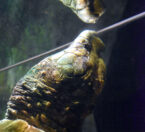These turtles use chemosensory cues to locate prey. Water drawn in and out of the mouth provides chemical clues given off by potential prey nearby. Using this sensory system, alligator snapping turtles are able to locate prey like mud turtles that have buried themselves in the mud at the bottom of the river.
Classification
| CLASS: | Reptilia |
| ORDER: | Chelonia |
| FAMILY: | Chelydridae |
| GENUS: | Macroclemys |
| SPECIES: | temminckii |
Habitat & Range
Alligator snapping turtles live in deep waters of large muddy rivers and associated major tributaries as well as lakes, canals, swamps, ponds and bayous.
This species occupies all river systems that drain into the Gulf of Mexico including the Mississippi up to Kansas, Iowa and Illinois. They are also found from northern Florida to southern Georgia along the Gulf coast states to eastern Texas.
Location


Adaptations
Here Fishy, Fishy!
Alligator snapping turtles have a soft, red, worm-shaped structure on the tongue that they use as a fishing lure. Sitting quietly on the muddy river bottom, concealed by their algae covered shell, they open their mouth and wait for prey to swim by. When a curious fish or other unwary prey tries to eat the decoy “worm”, the turtle’s massive jaws close on the prey.
Water Lovers
Alligator snapping turtles are unlikely to travel from water onto land. Generally only females venture onto land to lay their eggs. These turtles can stay submerged for 6-8 hours before they emerge from the water for air. This species can remain so still underwater that algae will cover their backs making them almost invisible to fish.
Sensing Prey
These turtles use chemosensory cues to locate prey. Water drawn in and out of the mouth provides chemical clues given off by potential prey nearby. Using this sensory system, alligator snapping turtles are able to locate prey like mud turtles that have buried themselves in the mud at the bottom of the river.
Physical Description
- The overall length of the alligator snapping turtle is up to five feet (1.52 m).
- The carapace or shell is up to 26 inches (66 cm) and has three lengthwise ridges.
- They weigh up to 250 pounds (114 kg).
- They are brown, gray or greenish in color and the shell is covered with algae.
- They have a huge head with powerful jaws and a hooked beak.
- The tail is as long as the shell.
- Unique among snapping turtles by having eyes on the side of their heads.
Diet
What Does It Eat?
In the wild:
These carnivorous turtles eat mostly fish, mollusks and other turtles but also consume some fruit and plant material that falls in the water.
At the zoo:
Fish and rats
What Eats It?
Turtle eggs and hatchlings are eaten by large fish, raccoons and birds. Adult turtles are used as a food source by humans.

Social Organization
Alligator snapping turtles are solitary except during mating.
Life Cycle
Mating occurs in the spring and about two months later the female builds a nest in sand or silt typically 50 yards (45 m) from the waters edge. She deposits a clutch of 10-50 leathery eggs in the nest. The female then returns to the water and the eggs are left to incubate. The sex of the hatchlings is determined by the temperature in the nest. In warmer areas of the nest females are produced; in cooler areas males are produced. The eggs hatch after 100-140 days; hatchlings are fully developed and totally independent from birth and must make their way to the water on their own. Both male and female alligator snapping turtles are sexually mature at 11-13 years of age. In the wild, alligator snapping turtles can live up to 45 years although 23 years is average. The oldest captive alligator snapping turtle lived 70 years.












